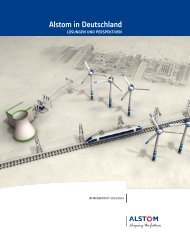MOROCCO IS ACCELERATING! feature - Alstom
MOROCCO IS ACCELERATING! feature - Alstom
MOROCCO IS ACCELERATING! feature - Alstom
Create successful ePaper yourself
Turn your PDF publications into a flip-book with our unique Google optimized e-Paper software.
62<br />
travel<br />
With its defeat in the Crimean War of 1856,<br />
Russia lost its strategic access to the Black<br />
Sea. Tsar Alexander II then looked for<br />
a Mediterranean port. He delegated several<br />
members of his family to convince the King<br />
of Piedmont and Sardinia, Victor-Emmanuel<br />
– who also possessed the County of Nice –<br />
to allow him to establish a naval, military<br />
and commercial base. This allowed him<br />
to position his fl eet in the Bay of Villefranche-<br />
sur-Mer. The fashion was launched.<br />
From 1864 onwards, the Tsar and the entire<br />
Russian nobility travelled to Nice by railway,<br />
transforming the town into a winter garden.<br />
There they built extraordinary buildings and<br />
magnifi cent residences, endowing Nice<br />
with an exceptional architectural heritage.<br />
Universal writers such as Chekhov<br />
and Tourgueniev joined this elegant society.<br />
After 1917, many White Russians<br />
fl eeing Bolchevism found refuge there as<br />
it was often the only town they knew outside<br />
their native country. Nearly a century later,<br />
the Russian public rail operator RZD<br />
has decided to revive this mythical service<br />
(ref. column page 67) by creating<br />
a remarkable two-day journey through<br />
the past.<br />
Before departure<br />
Moscow and the heart of the empire.<br />
The capital with ‘a thousand and three church<br />
towers and seven stations’ which so inspired<br />
Blaise Cendrars. The autumn is present<br />
here today in shades of black and white.<br />
It’s as if the colours have been inspired<br />
by the low sky. An atmosphere<br />
of mystery, which accentuates the majesty<br />
of the Kremlin’s high towers and blurs<br />
the perspectives of the long avenues.<br />
At the end of one of these, in a lashing<br />
of cold rain, the Belorussky station appears,<br />
the second largest of Moscow’s stations.<br />
A neoclassical building – later crossed with<br />
a touch of Soviet realism – the Belorussky<br />
was inaugurated in September 1870.<br />
Initially called ‘Smolensk’, it only received<br />
its fi nal name in 1936. Nevertheless, for many<br />
people today, it is simply the ‘station of<br />
victory’. The point of departure for soldiers<br />
leaving for the front in June 1941,<br />
it welcomed the returning victors in 1945.

















